As much as this blog is supposed to be writing reviews and such about the available self-study Japanese websites out there on the tubes, I'm still trying to find my voice by talking about work and work-related subjects.
I've talked about Hop Step Jump, Hop Step Jump events (student-run and company-run), and Learn-Japan.
All the photos I've posted so far have been work-related.
I've been all work, work, work.
So a bit of a break. Before I start cracking down and actually reviewing websites, I want to share Gifu.
The title of today's blog is a well-known quote from the Sengoku (Warring States) Period of Japan's history. The reason being, Gifu is the exact center of Japan. Literally. Geographically. The village of Minami in the northern city of Gujo is actually the dead geographical center of the Japan archipelago. I've been to the museum that has a huge pendulum-looking cone pointing to the exact center. Many of the postal codes in Gifu also start with 500 to signify how central of a location it is. Relative to the "big" cities of Tokyo and Osaka, it's roughly 396km (246 miles) to Tokyo and 217km (135 miles) to Osaka, making it roughly in the middle between two of the largest cities in Japan and the world.
While most in Gifu would consider it inaka (country) here, it's actually a pretty interesting area to live in. In way northern Gifu there's the Hida-Takayama area, known for it's mountains (considered a part of the Central Japanese Alps), sake, and for a large, old-style shopping district in Takayama City. Takayama City is also the largest city in surface area in Japan. There's a famous Shinto matsuri festival in spring and fall that I have been meaning to get to. The whole are gorgeous to go visit any time of the year, especially in fall and winter. They also sell good luck charms called sarubobo, and I have two Hello Kitty sarubobos I bought my first trip there. Sadly, my laptop died two years ago and I lost all of my photos from this area. I need to go again and get some good photos to share.
Nearby Hida-Takayama is Gero, which houses some famous onsen. The onsen has a huge fireworks festival every year that attracts a huge crowd from all over the country.
Gujo, which I mentioned further up the page, is west of Gero and is one of my favorite places in Gifu. Gujo is home to Gujo Odori, a huge dance festival in August celebrating the Bon Festival. If you've ever seen a picture of the famous Daimonji in Kyoto, it's for the same holiday. It's held in the Hachiman area of Gujo, and lasts a month. The most amazing part of this festival is in mid-August, usually around the 14th, where for four days the citizens of Hachiman and people form all over the country come to participate in tetsuya-odori, all-night dancing. I've gone two years in a row and plan on making it three this year.
Here are two of my photos from last year: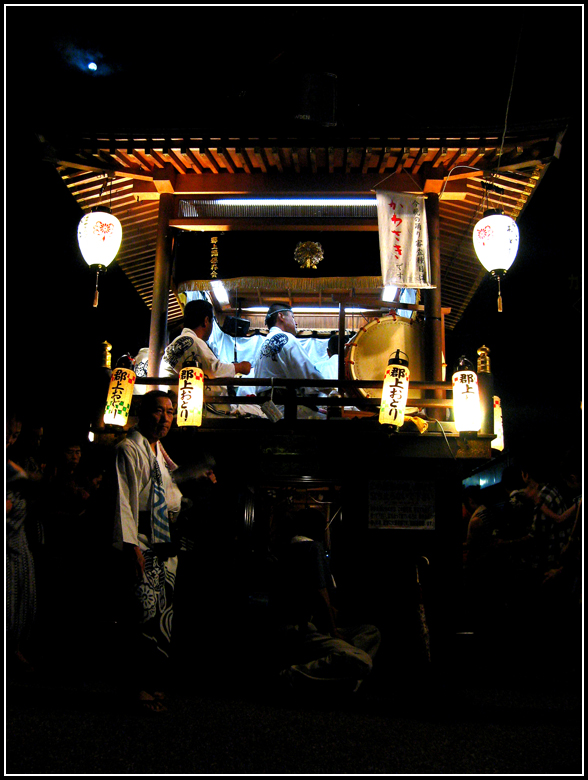
This is the little pagoda that is in the center of the dancing area. These poor old guys have to sing and play music all night from about 8pm until 4am while people have fun and dance around them.
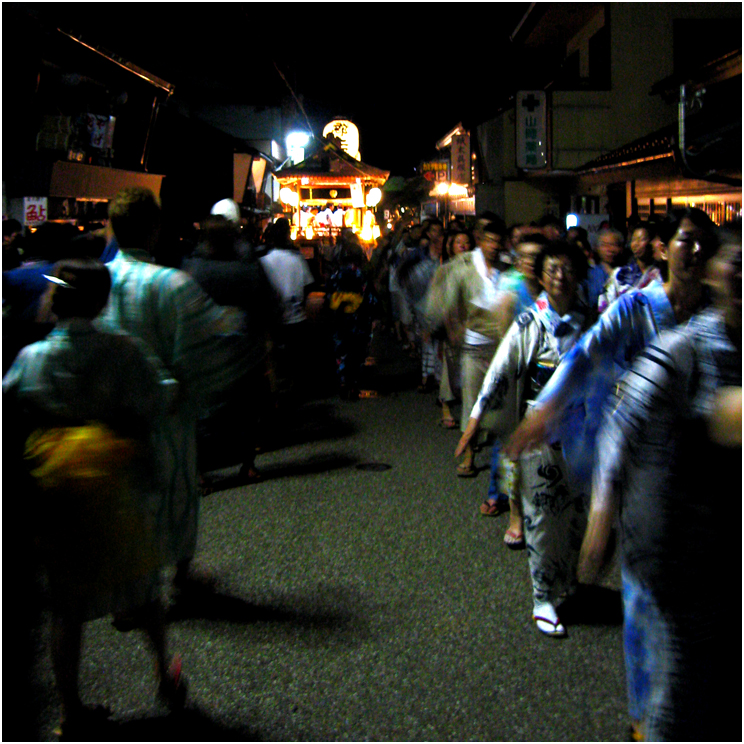
This is what it looks like in between the dance lines, looking towards the center. Usually the dancers are arranged in a plus shape, snaking down the four streets that create the intersection that the pagoda sits in.
Gujo also houses several caves which are open for tours and are awesome places to hide from the summer heat, as well as a "food replica" factory and store that is open for tours. Gujo-Hachiman actually produces 80% of the plastic food samples you see in restaurant and cafe windows across the country. The factory sometimes offers tours that allows visitors to try their hand at making their own leaf of lettuce to take home with them.
Heading south towards Gifu City brings you to Seki City, which has a 700-year-old history of sword making and cutlery. Four times a year they have demonstrations of the traditional methods of sword making, and also have ceremony for the first sword of the year at New Years. The Swordsmith Museum also houses one of the largest swords in the world, a katana that's a good 6 meters long. The area of Seki, and it's neighboring city of Mino, is pretty well known for unagi, or eel, as well. Makes for a tasty summer treat!
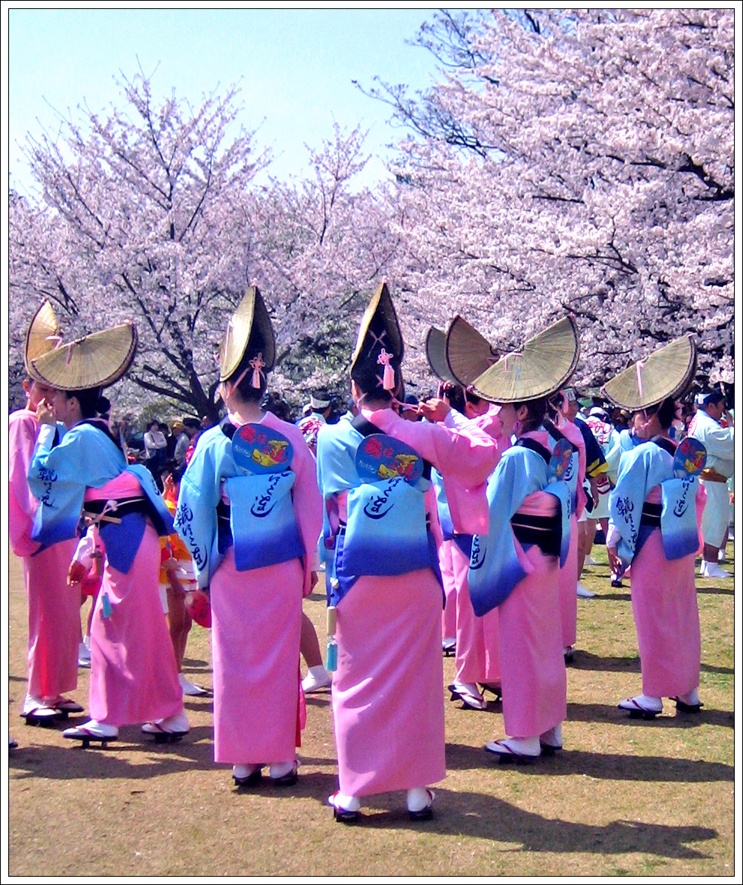 In southern Gifu, the big three cities are the capital, Gifu City, Kakamigahara City, and Motosu City. Kakamigahara, often called Mippara by citizens, houses several aeronautic companies that design and manufacture airplane parts, as well as a Self-Defense Force (formerly the Japanese Army) air base, both of which made the city a common air raid target during World War II. Currently, Kakamigahara is known for it's sakura in the city park and along the river banks.
In southern Gifu, the big three cities are the capital, Gifu City, Kakamigahara City, and Motosu City. Kakamigahara, often called Mippara by citizens, houses several aeronautic companies that design and manufacture airplane parts, as well as a Self-Defense Force (formerly the Japanese Army) air base, both of which made the city a common air raid target during World War II. Currently, Kakamigahara is known for it's sakura in the city park and along the river banks.
Motosu City is known for mainly three things: persimmons, Usuzumi-zakura, and MaLera.
Motosu is a large producer of fuyugaki persimmons, and groves of persimmon trees can be seen all over the city. If one asks someone from Gifu what a good gift from Gifu would be in the fall, most will suggest a box of persimmons before anything else.
The Usuzumi-zakura is the oldest sakura in Japan, believed to be over 1500 years old. The park where it is is now filled with many "babies" that have come from the central tree. It is a rare type of sakura that has pale pink blossoms that change to white at full bloom, and fade to a light gray as they fall. The sheer size of it is unlike any sakura I had ever seen. Hopefully I can go this year and actually take photos.
The MALera shopping mall in Motosu opened a few years ago, and is actually one of the largest malls in the country. It boasts 240 retail stores, a movie theater, food court, supermarket, and a "restaurant street" that stays open after the retail stores have closed. It is a paradise for mall-walkers, without a doubt.
Gifu City is where I'm stationed, and is the capital of Gifu Prefecture. It's a pretty decent sized city, and is quite easy to live in. There's a large JR station and one of the main Meitetsu stations in the center of town, as well as a shinkansen station about a 45 minute drive away over in Hashima City. First thing you notice when you get out of the train station is usually Gifu Castle sitting up on top of the mountain. Just as most of them are nowadays, it is a replica museum, but is a nice hike up Mt. Kinka to get there, or you could take the ropeway car up for $6 one way. Inside there is a lot of samurai armor, weapons, ninja weapons (yeah, real shuriken and the like), and a bunch of papers in Latin about a missionary who came during Oda Nobunaga's reign. Nobunaga's a weird historical figure in that he's become quite the legend. Appears in several video games as a "devil" figure, mainly because of how Japanese history portrays him. He was good at killing off those who opposed him, and allowed Christians onto his lands. Both of these got him the lovely title of "evil" when he was finally defeated.
Below the castle are several museums inside Gifu Park, including an insect museum and a city history museum, and down the street is Shōhōji Temple which houses one of Japan's largest Great Buddha statues. One of my co-workers told me it is not only the 3rd largest Buddha in Japan, but also the largest lacquered Buddha in Japan. Within a short walking distance from Gifu Park one will find Inaba Shrine, one of the three largest shrines in Gifu City. Inaba, along with Kogane Shrine and Kashimori Shrine (right down the street from my office), house a "family" of deities, with Inaba and Kogane shrines housing the parent gods, and Kashimori Shrine housing the child of the two. Every year in April the three hold joint festivals. In front of Inaba Shrine, one can also find the local branch of Zenkouji Temple. Seki City, which I mentioned earlier, also has their own branch of Zenkouji Temple which is much older than that of Gifu City.
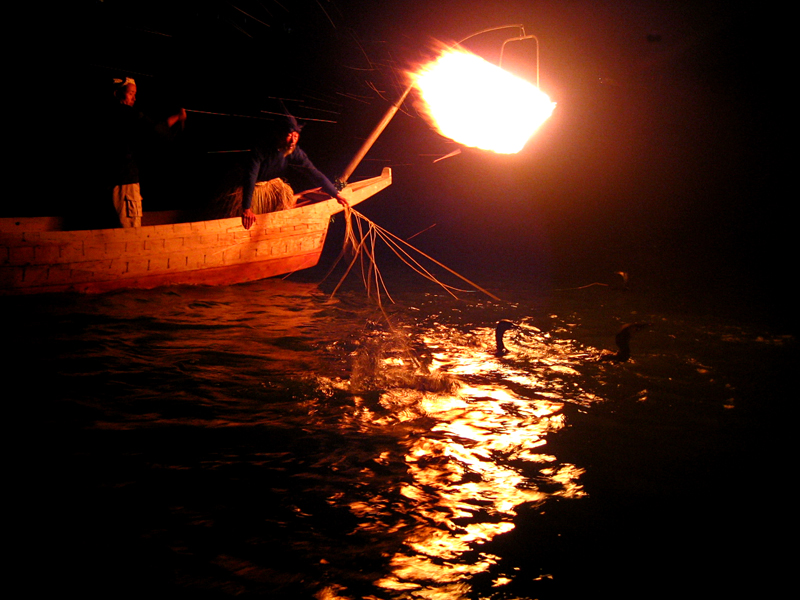
Possibly the most famous tourist attraction in Gifu City is it's historic cormorant fishing, Ukai, that occurs on the Nagara River between May and October. Gifu's section of the Nagara River is one of just a handful of places in Japan where this traditional night fishing still exists. Seki City, Inuyama City in Aichi Prefecture, and an area of Nara are the only places I've heard of that still practice this art. The tradition has been passed down through families, from father to son, for 1300 years. The houses where these families live are preserved as they were from Japan's past. Officially, these fishermen are under the watch of the Imperial Household Agency, and much of the first catch of the season is sent to the Imperial family as a gift. There are also areas of the Nagara River where fishing is prohibited as they are the official fishing spots for where the Imperial Family gets their Ayu, a type of Japanese sweetfish.
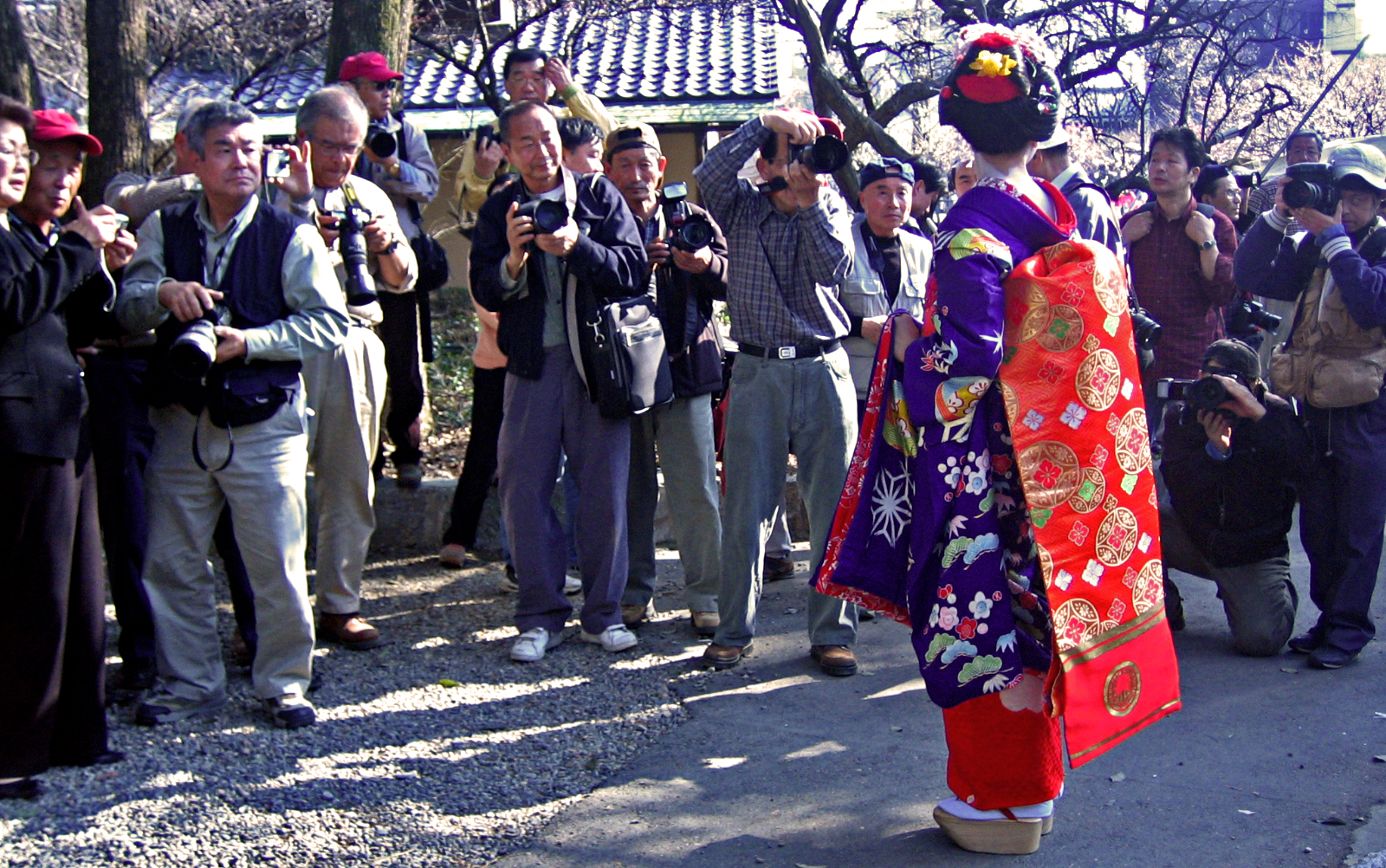
Another must-see in Gifu City, is Bairin Park, which houses 1300 Japanese plum trees. It offers 50 different varieties of plum trees, 600 of which are red or pink blossoms, and 700 are white varieties. A few of the red and pink varieties start blossoming as early as mid-January, and continue well through March. The Bairin Plum Festival, Bairin Ume Matsuri, is held the first weekend of March every year, with food booths selling all sorts of festival food, and local modeling companies bringing in models to pose with the blossoms for amateur photographers. Two years ago we had one model dressed up as a maiko, and last year we just had two girls in pretty dresses. The sheer amount of people with cameras is just amazing. Many also bring portable printers with them to print out their photos right then and there. Going to this festival is one of my favorite parts of living in Gifu, and I can't wait for this year's. Most likely I'll run into every single photographer you see in that above picture.
I could go on and on and on about things to see and do in Gifu, but I think I've droned on long enough. This took me two sessions at work to type all out. One last link I would like to share with you all is The Site of Reversible Destiny in Yoro Park, to the East of Gifu City. There is no other place like this in the world, and it is an incredible experience. It's slightly run down after being open for 10 years or so, resulting in a surreal, almost bad dream-like experience if you go on a cloudy day. I regret not taking my mother while she was here last summer. I think she would have gotten a kick out of it.
This is all my random rambling for now. Starting next month I'll be doing reviews of various websites to learn Japanese from, and possibly different ways to find work in Japan. Have to run that by my boss first.
Till next month!
I've talked about Hop Step Jump, Hop Step Jump events (student-run and company-run), and Learn-Japan.
All the photos I've posted so far have been work-related.
I've been all work, work, work.
So a bit of a break. Before I start cracking down and actually reviewing websites, I want to share Gifu.
The title of today's blog is a well-known quote from the Sengoku (Warring States) Period of Japan's history. The reason being, Gifu is the exact center of Japan. Literally. Geographically. The village of Minami in the northern city of Gujo is actually the dead geographical center of the Japan archipelago. I've been to the museum that has a huge pendulum-looking cone pointing to the exact center. Many of the postal codes in Gifu also start with 500 to signify how central of a location it is. Relative to the "big" cities of Tokyo and Osaka, it's roughly 396km (246 miles) to Tokyo and 217km (135 miles) to Osaka, making it roughly in the middle between two of the largest cities in Japan and the world.
While most in Gifu would consider it inaka (country) here, it's actually a pretty interesting area to live in. In way northern Gifu there's the Hida-Takayama area, known for it's mountains (considered a part of the Central Japanese Alps), sake, and for a large, old-style shopping district in Takayama City. Takayama City is also the largest city in surface area in Japan. There's a famous Shinto matsuri festival in spring and fall that I have been meaning to get to. The whole are gorgeous to go visit any time of the year, especially in fall and winter. They also sell good luck charms called sarubobo, and I have two Hello Kitty sarubobos I bought my first trip there. Sadly, my laptop died two years ago and I lost all of my photos from this area. I need to go again and get some good photos to share.
Nearby Hida-Takayama is Gero, which houses some famous onsen. The onsen has a huge fireworks festival every year that attracts a huge crowd from all over the country.
Gujo, which I mentioned further up the page, is west of Gero and is one of my favorite places in Gifu. Gujo is home to Gujo Odori, a huge dance festival in August celebrating the Bon Festival. If you've ever seen a picture of the famous Daimonji in Kyoto, it's for the same holiday. It's held in the Hachiman area of Gujo, and lasts a month. The most amazing part of this festival is in mid-August, usually around the 14th, where for four days the citizens of Hachiman and people form all over the country come to participate in tetsuya-odori, all-night dancing. I've gone two years in a row and plan on making it three this year.
Here are two of my photos from last year:

This is the little pagoda that is in the center of the dancing area. These poor old guys have to sing and play music all night from about 8pm until 4am while people have fun and dance around them.

This is what it looks like in between the dance lines, looking towards the center. Usually the dancers are arranged in a plus shape, snaking down the four streets that create the intersection that the pagoda sits in.
Gujo also houses several caves which are open for tours and are awesome places to hide from the summer heat, as well as a "food replica" factory and store that is open for tours. Gujo-Hachiman actually produces 80% of the plastic food samples you see in restaurant and cafe windows across the country. The factory sometimes offers tours that allows visitors to try their hand at making their own leaf of lettuce to take home with them.
Heading south towards Gifu City brings you to Seki City, which has a 700-year-old history of sword making and cutlery. Four times a year they have demonstrations of the traditional methods of sword making, and also have ceremony for the first sword of the year at New Years. The Swordsmith Museum also houses one of the largest swords in the world, a katana that's a good 6 meters long. The area of Seki, and it's neighboring city of Mino, is pretty well known for unagi, or eel, as well. Makes for a tasty summer treat!
 In southern Gifu, the big three cities are the capital, Gifu City, Kakamigahara City, and Motosu City. Kakamigahara, often called Mippara by citizens, houses several aeronautic companies that design and manufacture airplane parts, as well as a Self-Defense Force (formerly the Japanese Army) air base, both of which made the city a common air raid target during World War II. Currently, Kakamigahara is known for it's sakura in the city park and along the river banks.
In southern Gifu, the big three cities are the capital, Gifu City, Kakamigahara City, and Motosu City. Kakamigahara, often called Mippara by citizens, houses several aeronautic companies that design and manufacture airplane parts, as well as a Self-Defense Force (formerly the Japanese Army) air base, both of which made the city a common air raid target during World War II. Currently, Kakamigahara is known for it's sakura in the city park and along the river banks.Motosu City is known for mainly three things: persimmons, Usuzumi-zakura, and MaLera.
Motosu is a large producer of fuyugaki persimmons, and groves of persimmon trees can be seen all over the city. If one asks someone from Gifu what a good gift from Gifu would be in the fall, most will suggest a box of persimmons before anything else.
The Usuzumi-zakura is the oldest sakura in Japan, believed to be over 1500 years old. The park where it is is now filled with many "babies" that have come from the central tree. It is a rare type of sakura that has pale pink blossoms that change to white at full bloom, and fade to a light gray as they fall. The sheer size of it is unlike any sakura I had ever seen. Hopefully I can go this year and actually take photos.
The MALera shopping mall in Motosu opened a few years ago, and is actually one of the largest malls in the country. It boasts 240 retail stores, a movie theater, food court, supermarket, and a "restaurant street" that stays open after the retail stores have closed. It is a paradise for mall-walkers, without a doubt.
Gifu City is where I'm stationed, and is the capital of Gifu Prefecture. It's a pretty decent sized city, and is quite easy to live in. There's a large JR station and one of the main Meitetsu stations in the center of town, as well as a shinkansen station about a 45 minute drive away over in Hashima City. First thing you notice when you get out of the train station is usually Gifu Castle sitting up on top of the mountain. Just as most of them are nowadays, it is a replica museum, but is a nice hike up Mt. Kinka to get there, or you could take the ropeway car up for $6 one way. Inside there is a lot of samurai armor, weapons, ninja weapons (yeah, real shuriken and the like), and a bunch of papers in Latin about a missionary who came during Oda Nobunaga's reign. Nobunaga's a weird historical figure in that he's become quite the legend. Appears in several video games as a "devil" figure, mainly because of how Japanese history portrays him. He was good at killing off those who opposed him, and allowed Christians onto his lands. Both of these got him the lovely title of "evil" when he was finally defeated.
Below the castle are several museums inside Gifu Park, including an insect museum and a city history museum, and down the street is Shōhōji Temple which houses one of Japan's largest Great Buddha statues. One of my co-workers told me it is not only the 3rd largest Buddha in Japan, but also the largest lacquered Buddha in Japan. Within a short walking distance from Gifu Park one will find Inaba Shrine, one of the three largest shrines in Gifu City. Inaba, along with Kogane Shrine and Kashimori Shrine (right down the street from my office), house a "family" of deities, with Inaba and Kogane shrines housing the parent gods, and Kashimori Shrine housing the child of the two. Every year in April the three hold joint festivals. In front of Inaba Shrine, one can also find the local branch of Zenkouji Temple. Seki City, which I mentioned earlier, also has their own branch of Zenkouji Temple which is much older than that of Gifu City.

Possibly the most famous tourist attraction in Gifu City is it's historic cormorant fishing, Ukai, that occurs on the Nagara River between May and October. Gifu's section of the Nagara River is one of just a handful of places in Japan where this traditional night fishing still exists. Seki City, Inuyama City in Aichi Prefecture, and an area of Nara are the only places I've heard of that still practice this art. The tradition has been passed down through families, from father to son, for 1300 years. The houses where these families live are preserved as they were from Japan's past. Officially, these fishermen are under the watch of the Imperial Household Agency, and much of the first catch of the season is sent to the Imperial family as a gift. There are also areas of the Nagara River where fishing is prohibited as they are the official fishing spots for where the Imperial Family gets their Ayu, a type of Japanese sweetfish.

Another must-see in Gifu City, is Bairin Park, which houses 1300 Japanese plum trees. It offers 50 different varieties of plum trees, 600 of which are red or pink blossoms, and 700 are white varieties. A few of the red and pink varieties start blossoming as early as mid-January, and continue well through March. The Bairin Plum Festival, Bairin Ume Matsuri, is held the first weekend of March every year, with food booths selling all sorts of festival food, and local modeling companies bringing in models to pose with the blossoms for amateur photographers. Two years ago we had one model dressed up as a maiko, and last year we just had two girls in pretty dresses. The sheer amount of people with cameras is just amazing. Many also bring portable printers with them to print out their photos right then and there. Going to this festival is one of my favorite parts of living in Gifu, and I can't wait for this year's. Most likely I'll run into every single photographer you see in that above picture.
I could go on and on and on about things to see and do in Gifu, but I think I've droned on long enough. This took me two sessions at work to type all out. One last link I would like to share with you all is The Site of Reversible Destiny in Yoro Park, to the East of Gifu City. There is no other place like this in the world, and it is an incredible experience. It's slightly run down after being open for 10 years or so, resulting in a surreal, almost bad dream-like experience if you go on a cloudy day. I regret not taking my mother while she was here last summer. I think she would have gotten a kick out of it.
This is all my random rambling for now. Starting next month I'll be doing reviews of various websites to learn Japanese from, and possibly different ways to find work in Japan. Have to run that by my boss first.
Till next month!











